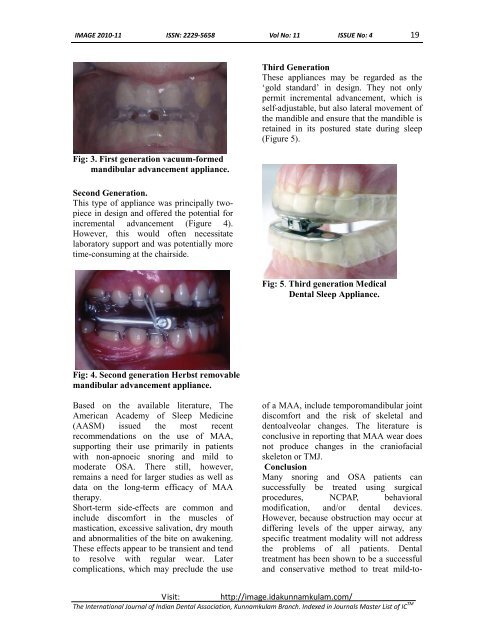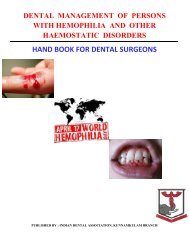'satisfactory smile' with a restorative approach - Indian Dental ...
'satisfactory smile' with a restorative approach - Indian Dental ...
'satisfactory smile' with a restorative approach - Indian Dental ...
Create successful ePaper yourself
Turn your PDF publications into a flip-book with our unique Google optimized e-Paper software.
IMAGE 2010-11 ISSN: 2229-5658 Vol No: 11 ISSUE No: 4 19<br />
Fig: 3. First generation vacuum-formed<br />
mandibular advancement appliance.<br />
Second Generation.<br />
This type of appliance was principally twopiece<br />
in design and offered the potential for<br />
incremental advancement (Figure 4).<br />
However, this would often necessitate<br />
laboratory support and was potentially more<br />
time-consuming at the chairside.<br />
Fig: 4. Second generation Herbst removable<br />
mandibular advancement appliance.<br />
Based on the available literature, The<br />
American Academy of Sleep Medicine<br />
(AASM) issued the most recent<br />
recommendations on the use of MAA,<br />
supporting their use primarily in patients<br />
<strong>with</strong> non-apnoeic snoring and mild to<br />
moderate OSA. There still, however,<br />
remains a need for larger studies as well as<br />
data on the long-term efficacy of MAA<br />
therapy.<br />
Short-term side-effects are common and<br />
include discomfort in the muscles of<br />
mastication, excessive salivation, dry mouth<br />
and abnormalities of the bite on awakening.<br />
These effects appear to be transient and tend<br />
to resolve <strong>with</strong> regular wear. Later<br />
complications, which may preclude the use<br />
Third Generation<br />
These appliances may be regarded as the<br />
ëgold standardí in design. They not only<br />
permit incremental advancement, which is<br />
self-adjustable, but also lateral movement of<br />
the mandible and ensure that the mandible is<br />
retained in its postured state during sleep<br />
(Figure 5).<br />
Fig: 5. Third generation Medical<br />
<strong>Dental</strong> Sleep Appliance.<br />
of a MAA, include temporomandibular joint<br />
discomfort and the risk of skeletal and<br />
dentoalveolar changes. The literature is<br />
conclusive in reporting that MAA wear does<br />
not produce changes in the craniofacial<br />
skeleton or TMJ.<br />
Conclusion<br />
Many snoring and OSA patients can<br />
successfully be treated using surgical<br />
procedures, NCPAP, behavioral<br />
modification, and/or dental devices.<br />
However, because obstruction may occur at<br />
differing levels of the upper airway, any<br />
specific treatment modality will not address<br />
the problems of all patients. <strong>Dental</strong><br />
treatment has been shown to be a successful<br />
and conservative method to treat mild-to-<br />
Visit: http://image.idakunnamkulam.com/<br />
The International Journal of <strong>Indian</strong> <strong>Dental</strong> Association, Kunnamkulam Branch. Indexed in Journals Master List of IC TM



